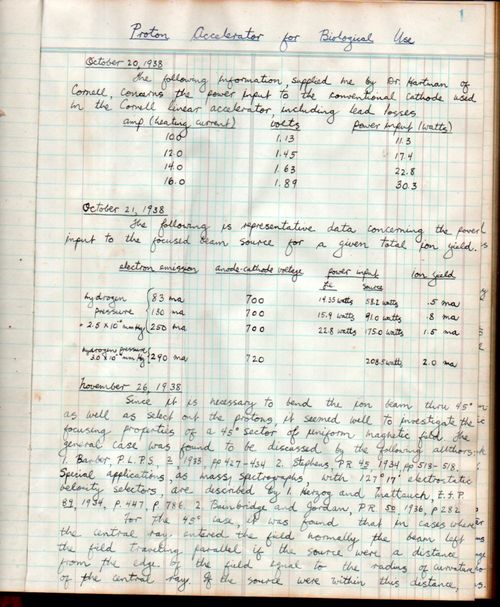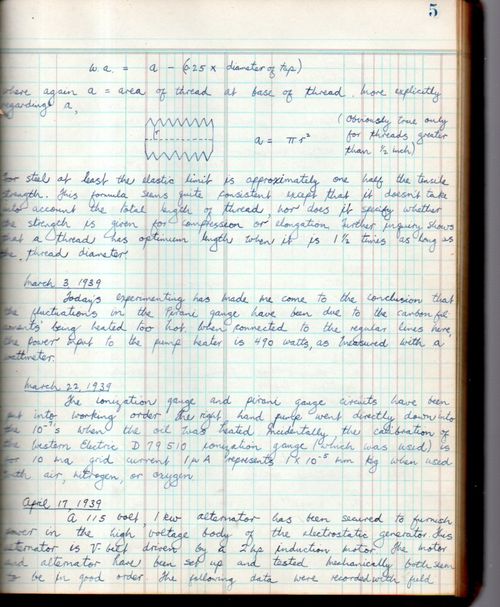JF Ptak Science Books Post 2356
Here's an example of some book detective work that I get to do, a lot. The book is actually a manuscript notebook, titled "Proton Accelerator for Biological Use" and kept by George W. Scott, jr., and written in a ledger book stamped "Haskins Laboratory"; the entries are from October 1938-April 14, 1941, and there's 65 pages of entries of about 21,000 words. It's concise and analytical, first-hand experiences and observations, notes kept by an experimenter to himself on constructing this machine. And the notebook came from the estate of Caryl Haskins, part of which I purchased years ago.
It turns out that the manuscript was fairly easy to figure out--tying everything up nicely in the end though wasn't so easy.
The "proton accelerator" notes was on the construction of the M.I.T. cyclotron, which was the world's first accelerator dedicated solely for meidical/biological use and a crucial instrument in the beginning of nuclear medicine.
The first bit of information that made everything fall into place was a notice in the June 1938 issue of Citizen-Advertiser of Auburn, NY which reported that a George W. Scott jr. was a Cornell grad awarded a $2000 fellowsihip by the Haskins Labs to work on a joint MIT/Harvard project for what would be a 500 kv proton accelerator, which was among the earliest of the cyclotrons (invented in 1932) and the first for MIT. The project was funded by a $30,000 gift from the John and Mary Markle Foundation to M.I.T. to construct a 42" cyclotron dedicated to biological and medical research and therapy. This project was under the direction of Robley Evans1 who brought aboard M. Stanley Livingstone (another Cornellian, who built a 2MeV machine at Cornell and most famously was co-inventor of the first successful atom-smasher with E.O. Lawrence in 1932, work which brought Lawrence the Nobel in 1939 but not Livingstone) to work on the accelerator. The machine ran successfully in November, 1938, and was completed in November 1940.
Scott was very hands-on in the project, though he makes infrequent references to others working on the project. He does mention John G. Trump (Ph.D. MIT '33, director of the high voltage lab and brother of D. Trump's father) and Jay Forrester (aa future Big Namer who at the time was a part-time research assistant in the high voltage lab under Trump). Also another major domo, LC van Atta, makes an appearance in the notes as does Prof. E.S. Lamar.
The troubling bit for me was that Dr. Scott seems to drop out of the physics world right there in 1941. I couldn't find him anywhere in Sci Abstracts or Sci Notations, nor in my indexes (invaluable!) for the Physical Review. Even after I realized that Scott may have been signing his papers with iterations of his name, I only found one paper that he wrote (as G.W. Scott) in 1939, and no other. It seemed odd to me that someone so close at hand and a contributor to a major project would just disappear.
A break came in checking out the Cornell Magazine and finding a small obituary notice for Scott, and that he died in November 1993 in Lancaster, Pa., aged about 70. A Brief notice in a Lancaster paper reports bare information, and then includes "Armstrong International" on one line. It turns out that Dr. Scott worked in some capacity for Armstrong World Industries (a huge concern and makers of flooring and ceiling elements), and there is evidence that he is there at least by 1944. My guess now is that with the beginning of American involvement in WWII that Scott was sent to Armstrong to help in some way for the company to retool production for the war effort.
That explains much of what I was wondering about with his seeming disappearance. How then did the book return to the Haskins Labs?
With the beginning of the war the cyclotron was used by the Office of Medical Research of the Office of Scientific Research and Development (OSRD) to produce tracers for use in medical experiments. According to the MIT News
"...During World War II, the cyclotron produced isotopes for three dozen research centers in the Boston area. Working with scientists and physicians from MIT and the Harvard Medical School, Dr. Evans attacked the problem of preserving whole blood...By using as many as two radioactive forms of iron and one of iodine--a so-called "triple tracer" experiment--doctors could determine how well transfused blood cells remained in a recipient's blood stream. A chemical was found to preserve the blood for up to three weeks, the time it required to reach distant battlefields and subsequently was used in blood banks for several decades."
There are also four pages of folded notes found inside the notebook, "Objectives for paper on and satisfactory completion of proton apparatus" (2pp) and "point to check when apparatus is given another trial" (2pp), written in Caryl Haskins hand. The connection between the MIT accelerator and Haskins is made because Haskins (Ph.D. physiology Harvard '35) had a long term interest in radiation, and had served as a research associate at MIT from 1935-1945; more significantly he was a liasion officer and senior liasion officer at OSRD from 1941-3, and then served as the great Vannevar Bush's executive assistant from 1943-1945. (Haskins would later succeed Bush as president of the Carnegie Institution of Washington, a post he held from 1956-1971 and served as a trustee there from 1949-2001 (!)), among much else in a very distinguished career in public service and in many fields across the sciences.
There is at least one direct reference to Scott and Haskins made in Nye's oral history of Haskins Laboratories (An Oral History of Haskins Laboratories, by Patrick Nye, 2006, page 35), made in 1988, where Scott's arrival is mentioned and the reason for him being there:
"At some place along the line, 1938 or 1939, George Scott, who is covered in, your write up, I think, came in to do the same kind of job on biological materials that Caryl and I had started with electrons, but do it with protons. This was obviously motivated by the growing interest in the neutron in nuclear physics."
Scott does not seem to have made it further than 1941 with the cyclotron, but it certainly seems as though his notebook did, and could well have been very useful to Haskins & company as the instrument went into wartime use in 1942...and that Dr. Haskins thought enough of it to keep the book for 50+ years afterwards.
Notes
1. (The DOE stated that Professor Evans, as a founder of nuclear medicine, "occupies a special place in the history of radiation physics and biology and the development of our understanding of radiation effects today. He has had a unique impact on radiation biology."--MIT News, obituary for Evans, 1993)





Comments